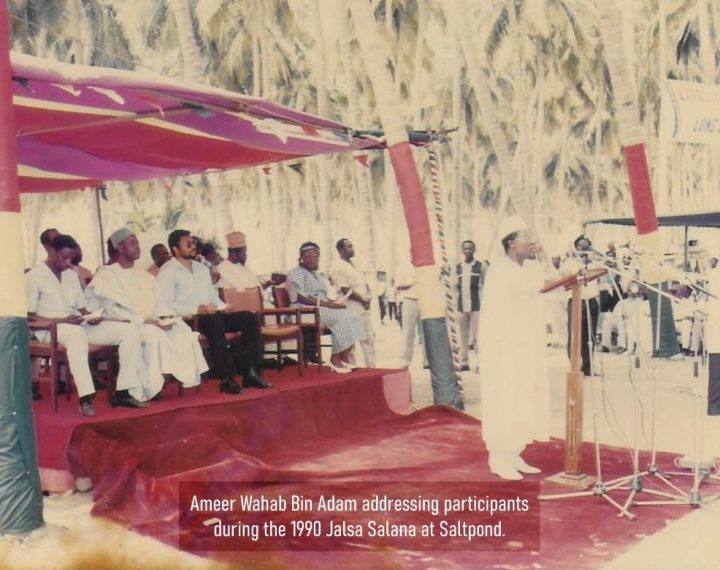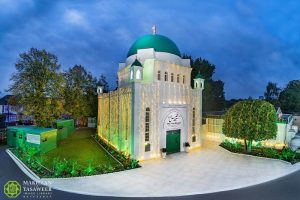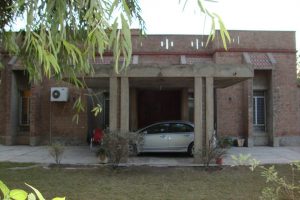The Ahmadiyya Muslim Community was founded by the Hazrat Mirza Ghulam Ahmad (as) in March 1889. Allah the Almighty told him that he was the Promised Messiah and Imam Mahdi and gave him glad tidings that his message would reach the corners of the earth. Allah promised him that his community would flourish, that he would be blessed, so much so that kings would seek blessings from his garments. This was at a time when he was virtually unknown. Since his demise in 1908, the community has gone on to reach the corners of the earth, as the Promised Messiah (as) had prophesied. In Africa, the community has progressed rapidly under the guidance of the Khulafa. In the blessed era of the Fifth Khalifa of the Promised Messiah (as), Hazrat Mirza Masroor Ahmad (aba), Ahmadiyyat has greatly progressed in Africa. By the Grace and blessings of Allah the Almighty, this year sees 102 years of the Ahmadiyya Muslim Community in Ghana.

Early Ahmadiyya in Ghana
The sub-Saharan region of Africa first heard about the Ahmadiyya Muslim Community in 1916. The message of the Ahmadiyya Muslim Community was brought to this part of Africa by a Nigerian trader in Islamic literature from Cairo. This trader had brought the Review of Religions magazine from Britain to Lagos in Nigeria. This magazine intrigued many young Muslims, who were ready to accept Ahmadiyyat at the time [1].
In Ghana, then the Gold Coast, a nascent group of Sunni Muslims and ex-Christians among the Fante people in the southern region also heard of Ahmadiyyat through a Nigerian Ahmadi, who was living in the south of Ghana, when Yusuf Nyarko, a Fante, dreamt that “white” men were leading his community of Muslims in prayer. Upon discovering the existence of a community in South Asia, the Ghanaian Muslims took the unique initiative to contact Hazrat Khalifatul Masih II (ra) in Qadian through the Review of Religions and requested that a missionary be sent to teach them Islam. In 1921, His Holiness (ra) therefore sent Hazrat Maulvi Abdur Rahim Nayyar sahib to Ghana, thereby sowing the seed of Ahmadiyyat for the first time in Africa. It is indeed a sign of the truthfulness of the Promised Messiah (as) that Ahmadiyyat reached Africa through a dream [2].
The arrival of Ahmadiyyat in Ghana was a thing of joy and struggle. It was joyous in the fact that the prophecy of Ahmadiyyat reaching Africa and all corners of the world had come to pass, and the struggle for many if not all of the early Ahmadi converts was enormous. Even though some part of Ghana was already occupied by Muslims it was not easy for those who had accepted Ahmadiyyat, to convince and preach the new found faith to the fellow Muslims. The arrival of Ahmadiyyat at that time was like a sudden wind that brings change, for the Christians it was more of “people belonging to a false religion” attempting to lead them astray, while for the Muslims it was more about unreadiness to accept the truth about Islam and its teachings that came with Ahmadiyyat. This was because these people already had certain practices that they took part in, thus any other practice that would attempt to falsify or demonise their own practice was a threat and also unacceptable.
Regardless of the fact that in places like Wa, Upper West Region of Ghana, prophecies and revelations had already been made by Orthodox Muslims of the Wala ethnic group (from the Upper West region of Ghana), many Wala people refused to accept the message of Ahmadiyyat at that time. The first handful of Wala Muslims who had accepted Ahmadiyyat were excommunicated from Wa, they were not allowed to enter their own town because they had converted to Ahmadiyyat. They were affronted, beaten and threatened with death by either beatings or poisoning. Curses and threats were made on whoever granted early Ahmadis shelter or any sort of help, due to the fear of sanctions and the curses many people detested them. Farm lands were seized and marriages with Ahmadis were no longer allowed. This antagonism and stigma forced some to renounce the newly accepted faith so they would be accepted back into their town [3].
In order for Ahmadis to stay in Wa, there were some conditions that they had to live by and obey, these conditions included that they had to remain indoors, their children were not allowed to go to the farms to bring food and their wives were not allowed to go to the markets or streams. All this was a clear attempt to keep them locked up and starved until they died. Refusal to comply with these conditions led to attacks and riots against the Ahmadis, but by the grace of Allah, the increasing riots led to the successful spreading of Ahmadiyyat, as the kinsmen and clansmen of the early Ahmadis came together to defend them from violence incited by others. This riot led to the conversion of many non-Ahmadis, as they were inspired by the courage, valour and spiritual strength of the Ahmadis who fought and stood by their faith. Regardless of the persecution increasing day by day, they remained steadfast and resolute. They were ejected from their houses simply because they prayed with their arms folded and because of their belief that the Mahdi had come [4].
As more people accepted Ahmadiyyat, the need arose for a mosque to be built. Due to the discrimination and hatred towards Ahmadis at that time, the construction of a mosque and the calling of Azan were the two main herculean things to do in Wa, any time the Azan was called for prayers (especially on Fridays) it was like Ahmadis had declared war in Wa. Non-Ahmadis left no stone unturned to prevent the construction of an Ahmadi Mosque. The man who brought Ahmadiyyat to Wa, Alhaj Imam Salih had to convert one of his rooms into a mosque, just so they could have congregational prayers. Even at that the non-Ahmadis still had a problem with hearing the Imam give religious sermons and discourses from his little room. Thus, they wanted all the windows and doors of the house to be sealed so that no sound would be heard outside, when they failed to achieve that, they attempted to demolish the house. All attempts failed, and the number of converts kept increasing, thus in pursuit of a bigger mosque, Imam Salih had to pull down the wall to his house to make it bigger for the congregants to fit in [5].
Alhamdulillah, an Ahmadi Mosque was finally built, however they did not have means of roofing the mosques as any stick or log they attained to roof the mosque was seized by chiefs and elders of neighbouring towns under the instruction of the Wa authorities (chief). They even had to go as far as Kumasi (in the Ashanti Region of Ghana) to purchase wood for the windows and door of the mosque. As a result, the mosque remained unroofed from the year 1943 until the year 1954, after which they all came together to build a modern mosque with cement. Everyone – including men, women, the old and young, rich and poor – came out as a community to help in building the mosque, some came with money, others came with building materials, while some provided refreshment for the workmen and workwomen. Through hard work, sacrifice and dedication, the mosque was finally completed in 1961 [6].
Ahmadiyyat in Ghana Today: The blessings
There is no doubt that Ahmadiyyat has come far in Africa. In the last decade, the Nigerian Jama’at celebrated its centenary, and nearly 30,000 people from surrounding countries attended this Jalsa. Sierra Leone likewise held their centenary celebrations, and they too attracted large numbers of Ahmadis from around the country and foreign guests [7]. By the Grace of Allah the Almighty, the Ghanaian Jama’at will be celebrating its centenary, and we anticipate the arrival of thousands of our fellow brothers and sisters to celebrate with us.
In some countries, the Jama’at has been directly involved in efforts to gain independence, and by truly recognizing that love for one’s country is part of faith, Ahmadi Muslims in Africa have always tried to play an active role in their country. For example, the involvement of the Sierra Leonean Jama’at in the achievement of Sierra Leone’s independence, through humanitarian services; as well as the involvement of one of the Ahmadiyya Muslim Community Local Tanzanian missionaries, Sheikh Amri Abedi, who use to give the government of Tanzania counsel and advice. One of his other rendered services was giving the leaders of this country at that time, the name Tanzania upon the recommendation of an Asian Ahmadi Muslim [8].
The Jama’at has been successful in opening missionary training centres in many countries in Africa, including Ghana. Currently, Jamiatul Mubashireen is operating in countries like Ghana, Tanzania, Sierra Leone, Nigeria, and Burkina Faso. During the blessed era of the Fifth Caliph, Allah the Almighty has blessed the Jama’at with the establishment of a Jamia Ahmadiyya International in Ghana, which offers a seven-year course on religious education, and is open for students from all African countries and beyond [9].
In August 2016, MTA Africa was launched when the need for a channel specifically for viewers in Africa was sorely needed [10]. As part of this wonderful establishment of an Ahmadiyya TV channel, on the 15th of January 2021, Hazrat Khalifatul Masih V (aba) officially launched MTA Ghana. A new digital terrestrial television channel established specifically to meet the needs of the people in Ghana [11]. Highlighting one of the unique aspects of the channel, Hazrat Khalifatul Masih V (aba) stated: “The channel will be utilised to convey the true and beautiful teachings of Islam to the people, God willing. MTA Ghana is the only channel on a digital platform in the country that is solely dedicated to broadcasting Islamic teachings.” [12] Today, MTA studios in Ghana, Nigeria, Mali, and many other African countries are producing multiple programmes specifically designed to educate African viewers in their language.
In trying to help girls and boys memorise the Holy Quran, the Jama’at has established schools or madrassas in many African countries including Ghana.
Today the Ahmadiyya Muslim Community of Ghana boasts of about 200 or more mosques built across the country. Years ago, Ahmadis struggled to get a single mosque, but look at us today, we have 200 and more. The Ahmadiyya Muslim Jama’at boasts of its own printing press called Raqeem Press where they print all their books and other literature to continue spreading the message of Islam Ahmadiyya. The Jama’at is also involved in numerous humanitarian projects through the Humanity First foundation, which provides water (through the Water for Life project) as well as electricity to villages and settlements that do not have it. In pursuit of spreading knowledge and education, the Jama’at has built and established more than 500 schools, including one training college and about eight senior high schools. In contributing to the provision of health service in Ghana, the Jama’at has established about 10 health care facilities, about 7 of them are hospitals while about 2 of them are homeopathic clinics, and one is a herbal clinic. The Ahmadiyya Muslim Jama’at of Ghana can also boast of about 13 mission houses across Ghana [13].
Conclusion
It may have not been an easy journey especially for the early Ahmadis who accepted the faith during its early days in this part of the world, however, through the guidance and blessings of Allah the Almighty, the Khulafa have guided and led Ahmadis for 102 years now. Today we live to witness and enjoy all the blessings and achievements that come with this great Jama’at. Despite all the trials and tribulations, through steadfastness and sacrifices, Ahmadis from that time have successfully spread the message of Ahmadiyyat across many regions in Ghana and we live to see the success of Ahmadiyyat today after 102 years of setbacks, victories, sacrifices, joy, pain, knowledge, and growth, all through the Grace of Allah. In Holy Qur’an chapter 2 verses 155-157, Allah the Almighty says “And say not of those who are killed in the cause of Allah that they are dead; nay, they are living; only you perceive not. And We will try you with something of fear and hunger, and loss of wealth and lives, and fruits; but give glad tidings to the patient, Who, when a misfortune overtakes them, say, ‘Surely, to Allah we belong and to Him shall we return.’ [14] This has been proven by the success and blessings the Ahmadiyya Muslim Jama’at of Ghana see today.
About the author: Raqeeba Mwiniya Abass holds a Bachelors degree in Psychology. She is currently pursuing her Master of Philosophy degree in Developmental Psychology at the University of Ghana
Endnotes
- Mehmood, J. (2022, April 13th). Islam Ahmadiyyat in Africa – Fulfillment of a Grand Prophecy. Review of Religions. Retrieved October 23rd , 2023, from https://www.reviewofreligions.org/38121/islam-ahmadiyyat-in-africa-fulfillment-of-a-grand-prophecy/
- Hanson, J. H. (2017). The Ahmadiyya in the Gold Coast. Indiana: Indiana University Press. 163–180; Adam, A. W. (1990, September 18). Ahmadiyyat in Ghana. The Review of Religions, 85(9). Retrieved October 23rd, 2023, from https://www.reviewofreligions.org/8236/ahmadiyyat-in-ghana/
- Adam, A. (2016). History of Ahmadiyyat in upper west region. p-20.
- Adam, A. (2016). History of Ahmadiyyat in upper west region. p-30-32
- Adam, A. (2016). History of Ahmadiyyat in upper west region. p-34
- Adam, A. (2016). History of Ahmadiyyat in upper west region. p-34-35
- Quraishi, A. H. (2021, March 12). 100 years of Ahmadiyyat in Sierra Leone: Three days of centenary celebrations. Al Hakam (56), pp. 6-7. Retrieved October 23rd , 2023, from https://www.alhakam.org/100-years-of-ahmadiyyat-in-sierra-leone-three-days-of-centenary-celebrations/
- Hazrat Mirza Masroor Ahmad (aba) (2012, January 28). Pan African Address. Retrieved October 23rd , 2023, from Review of Religions: https://www.reviewofreligions.org/5408/pan-african-address/
- For more information, please see About – Jamia Ahmadiyya International Ghana: https://www.jamiaghana.org/about/
- Muslim Television Ahmadiyya International (MTA). Retrieved October 23rd , 2023, from Ahmadipedia: https://www.ahmadipedia.org/content/institution/12/muslim-television-ahmadiyya-international-(mta)
- GNA. (2021, January 17). Ghanaian Ahmadis to benefit from new terrestrial TV Channel. Retrieved October 23rd , 2023, from News Ghana: https://newsghana.com.gh/ghanaian-ahmadis-to-benefit-from-new-terrestrial-tv-channel/
- Head of Ahmadiyya Muslim Community Launches MTA Ghana TV Channel. (2021, January 16). Retrieved October 23rd , 2023, from Ahmadiyya Muslim Community Press & Media Office: https://www.pressahmadiyya.com/press-releases/2021/01/head-of-ahmadiyya-muslim-community-launches-mta-ghana-tv-channel/
- Hafiz Syed, M.A (2008). Khilafat Centenary Jubilee Souvenir, Ghana.
- The Holy Quran chapter 2 verses 155-157.




Add Comment